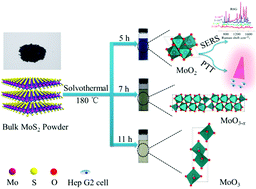Our official English website, www.x-mol.net, welcomes your feedback! (Note: you will need to create a separate account there.)
Phase-controlled synthesis of molybdenum oxide nanoparticles for surface enhanced Raman scattering and photothermal therapy†
Nanoscale ( IF 6.7 ) Pub Date : 2018-02-20 00:00:00 , DOI: 10.1039/c8nr00413g Yan Zhan 1, 2, 3, 4 , Yingliang Liu 4, 5, 6, 7 , Hongru Zu 1, 2, 3, 4 , Yanxian Guo 4, 8, 9, 10, 11 , Shuangshuang Wu 4, 5, 6, 7 , Haiyao Yang 4, 8, 9, 10, 11 , Zhiming Liu 4, 8, 9, 10, 11 , Bingfu Lei 4, 5, 6, 7 , Jianle Zhuang 4, 5, 6, 7 , Xuejie Zhang 4, 5, 6, 7 , Di Huang 1, 2, 3, 4 , Chaofan Hu 4, 5, 6, 7
Nanoscale ( IF 6.7 ) Pub Date : 2018-02-20 00:00:00 , DOI: 10.1039/c8nr00413g Yan Zhan 1, 2, 3, 4 , Yingliang Liu 4, 5, 6, 7 , Hongru Zu 1, 2, 3, 4 , Yanxian Guo 4, 8, 9, 10, 11 , Shuangshuang Wu 4, 5, 6, 7 , Haiyao Yang 4, 8, 9, 10, 11 , Zhiming Liu 4, 8, 9, 10, 11 , Bingfu Lei 4, 5, 6, 7 , Jianle Zhuang 4, 5, 6, 7 , Xuejie Zhang 4, 5, 6, 7 , Di Huang 1, 2, 3, 4 , Chaofan Hu 4, 5, 6, 7
Affiliation

|
Different from their bulk counterparts, plasmonic molybdenum oxide nanomaterials display superior optical and electronic properties, but unfortunately, phase-controlled synthesis of molybdenum oxide nanomaterials with multifunctional performances still remains a challenge. To actualize this, a surfactant-free solvothermal strategy was proposed to fabricate molybdenum oxide nanomaterials with a tunable phase. Encouragingly, the as-prepared molybdenum dioxide nanoparticles (MoO2 NPs) exhibit intense near-infrared (NIR) absorption attributed to the localized surface plasmon resonance (LSPR) effect, which results in their application as a surface enhanced Raman scattering (SERS) substrate to detect trace amounts of molecular species including Rhodamine 6G (R6G), crystal violet (CV), IR-780 iodide (IR780) and methylene blue (MB). The detection limit was as low as 5 × 10−8 M and the maximum enhancement factor (EF) was up to 1.10 × 107, compared to other semiconductor nanostructures, the SERS sensitivity may be the best. Meanwhile, with the significant photothermal conversion efficiency up to 61.3%, the plasmonic MoO2 NPs could also be used as a photothermal therapy (PTT) agent for efficient photothermal ablation of cancer cells in vitro.
中文翻译:

用于表面增强拉曼散射和光热疗法的相控合成氧化钼纳米粒子†
不同于体相的等离子氧化钼纳米材料显示出优异的光学和电子性能,但不幸的是,具有多功能性能的氧化钼纳米材料的相控合成仍然是一个挑战。为了实现这一点,提出了一种无表面活性剂的溶剂热策略来制备具有可调相的氧化钼纳米材料。令人鼓舞的是,所制备的二氧化钼纳米颗粒(MoO 2NPs)表现出归因于局部表面等离振子共振(LSPR)效应的强烈近红外(NIR)吸收,这导致它们可作为表面增强拉曼散射(SERS)底物应用来检测痕量的分子物种,包括罗丹明6G(R6G) ),结晶紫(CV),IR-780碘化物(IR780)和亚甲基蓝(MB)。与其他半导体纳米结构相比,检测限低至5×10 -8 M,最大增强因子(EF)高达1.10×10 7,SERS灵敏度可能是最好的。同时,等离子MoO 2 NPs的显着光热转换效率高达61.3%,还可以用作光热疗法(PTT)剂,以有效地消融癌细胞。体外。
更新日期:2018-02-20
中文翻译:

用于表面增强拉曼散射和光热疗法的相控合成氧化钼纳米粒子†
不同于体相的等离子氧化钼纳米材料显示出优异的光学和电子性能,但不幸的是,具有多功能性能的氧化钼纳米材料的相控合成仍然是一个挑战。为了实现这一点,提出了一种无表面活性剂的溶剂热策略来制备具有可调相的氧化钼纳米材料。令人鼓舞的是,所制备的二氧化钼纳米颗粒(MoO 2NPs)表现出归因于局部表面等离振子共振(LSPR)效应的强烈近红外(NIR)吸收,这导致它们可作为表面增强拉曼散射(SERS)底物应用来检测痕量的分子物种,包括罗丹明6G(R6G) ),结晶紫(CV),IR-780碘化物(IR780)和亚甲基蓝(MB)。与其他半导体纳米结构相比,检测限低至5×10 -8 M,最大增强因子(EF)高达1.10×10 7,SERS灵敏度可能是最好的。同时,等离子MoO 2 NPs的显着光热转换效率高达61.3%,还可以用作光热疗法(PTT)剂,以有效地消融癌细胞。体外。



























 京公网安备 11010802027423号
京公网安备 11010802027423号